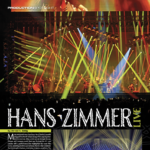
Country Singer/songwriter/rapper Jelly Roll (aka Jason DeFord) started his musical career selling his mix tapes out of his car over a decade ago. Today he has built a massive following and on Feb. 11 made history on Billboard’s latest Emerging Artists chart with his record-breaking 25th week at No. 1. His recent hits include “Need a Favor” along with the mid-January Country Airplay chart topping No. 1 “Son of a Sinner.”
From Nashville, TN, having been born and raised in Antioch, Jelly Roll, is the first to acknowledge his past history of making bad choices early in his life. As he finds mainstream success now with his music, he draws from his life’s journey, blending old-school rap, classic rock, country, and soul. The 38-year-old noted in a songwriting interview that, “My music is all based on emotions and stories from my life as well as people around me. I want to convey to people the power of faith and perseverance and I hope that it helps them to find a light in whatever darkness they may be going through in their life.”
Jelly Roll ended 2022 headlining his first arena concert, in his hometown at Nashville’s sold-out Bridgestone Arena. Helping to capture his music and his story in the show’s design were Lighting Designer Bobby Grey of Notan Creative and Creative Director, David Pawsey of Lüz Studios. PLSN spoke with both designers about their work on the show.
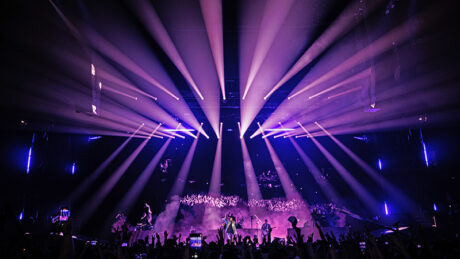
Bobby Grey, Lighting Designer
Where did you start with the design?
Nick Whitehouse from Fireplay was the Creative Producer and Josh Zangen was the Production Designer. Josh put together the idea for the giant video wall upstage. They then brought in Lüz Studio to build all the content, these environmental sets. So, we all collaborated from the outset; getting on weekly calls and talking about how to bring those environments forward.
We wanted to lean into this aesthetic of his having been underground in Nashville. He’s been playing these shows everywhere for some time, from big festival stages down to just little clubs. Now he’s growing out of that world and moving forward in his career. Bridgestone was his coming out party and his step to the next level. The core concept was this being his first big arena show to really bring him out as this big, massive arena artist. So, for the opening of the show there was a diamond-shaped stage built out in the middle of the audience and I put a diamond-shaped truss over it which I surrounded with GLP JDC1s and Robe FORTES. We were able to get that stage really bright to make it look like a boxing ring. Then Michael Buffer, the “Let’s Get Ready to Rumble” boxing announcer opens the show. We kept the actual mainstage dark. We didn’t really reveal that at the beginning, we just had big sweeping ballyhoos from the audience trusses, which had JDC1s and FORTES all over them and Quantum Washes. We did big sweeping washes all over the stage and all over the audience, really building excitement and energy. It was cool and worked well.
Then for the lighting design on stage, we really wanted to augment the 3D environments from Lüz. Those were the center of the show and needed to be the focus, so we wanted to augment them. Really bring the lighting down from those and create some feeling of grandeur to the space out of those environments to the downstage. To do that, I did three trusses that followed the curve of the video wall. The video wall actually curved upstage, and we brought the trusses around to follow that shape. Those trusses were lined with Robe BMFL WashBeams and MegaPointes. And then we lined all of the front edges of the trusses with Flare LRs, which gave us tons of brightness. I also had vertical ladder trusses on stage right and stage left that we also lined with Flare LRs and MegaPointes. The MegaPointes gave us the ability to either take everything really tight and have tight beams and traditional chases or we were able to go super wide. They let us go really wide with gobos and texture and fill the air with soft textures. It was great to be able to also use them to then pull it all down for the more intimate moments.
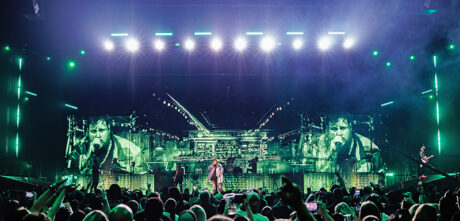
Talk about the challenge of creating different looks over the course of the performance.
Keeping it fresh is always a challenge and I deal with that a lot. It was no different with this one. We didn’t want just the different set environments to look different, but every song to have its own look. The three things that really helped us with that was first, as I mentioned the versatility of the fixtures that we used—the MegaPointes and the JDC1s. And second was the amount of pixels that we were able to have to break up over the stage, we were able to create a lot of different shapes, we could even lose the shape of the rig when we wanted to lose it. For example, there are a couple songs that are based on fire. So, for one of the environments, the trailer park, there is a point when it is burning behind him. There’s another moment that he walks into a church environment and the church catches on fire around him and burns down. In terms of lighting, since we had these MegaPointes, we were able to use all the animation characteristics that they have to create a really nice texture. We could send really neat warm ambers and red pixel effects that looked like fire through the pixels. And we just totally lost the shape of the stage and had what felt like a fire effect happening around him.
Something that I think really played well was the stage deck itself was all grated. And so, I put a whole array of Robe Spiider fixtures underneath the grated deck, and we could shoot up through the deck. So, there were moments where he’s just lit by this light coming through the deck and there is fire going off around him. I also put a bunch of MegaPointes as well below, so we were able to bring texture up through. We got some good mileage out of the lighting below the grated deck. Another big thing that got us through a lot of the show was that we had two lines of JDC1s, like 32 on either side, that lined the bottom edge of the stage behind the band. Those were really versatile. When we needed to bring a bunch of lumens out, we could bring those up to full with the Flare LRs in white and get a really big white push.
The third critical piece to this whole thing was our Robe RoboSpots. We were able to put followspots in the perfect position for key lighting at obscure locations. For example, one note from management was they didn’t want it to look like a traditional followspot; they didn’t want to see a circle on the ground following him around. They wanted it to really feel like he was in a bar, not in a theater, so we were able to put texture in the followspots and we were able to come from really great angles. Another example was for the song ‘Creature’ where he wanted a really hard modeling to come right across his face and only be lit from one side. For that we had a followspot at 90˚ from his main position, way up, right over the seats. It’s great to be able to take a light that is so versatile and drop it anywhere in the arena where you need it and not worry about it being able to control it. With PSN [PosiStageNet] we were able to bring it in and grab other lights to be his backlight. We were able to grab him, track him, and then use multiple lights to track his position. So, yeah, the RoboSpot system was an integral part of this show looking good and getting us exactly what we wanted as far as key lights from different directions.
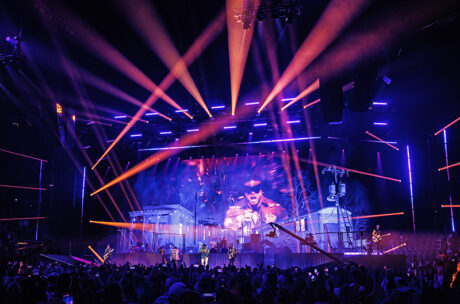
Tell us more about integrating the lighting with the environmental sets content on the video wall.
What’s so great about Lüz is they build not only these really beautiful sets and they’re rendered out so perfectly in 3D, but they’re also very creative about how they control it. So, they have in any given scene hundreds of different layers of lights that they can bring on and off. And so, we were able to build these scenes together and really coordinate our hits. There were moments that I was triggering them, there were moments they were triggering me. We were able to pass triggers back and forth between our show files and we were also just aesthetically really able to work together and build environments that continue out.
Lüz built out these amazing 3D environments where he’s standing in front of the trailer park and with the parallax effect, it looks like the stage is continuing back into the trailer park. Then they are able to change the weather behind him, they’re able to have a barrel burning, they can change the lights inside of the trailers, and on the trailers. Same thing for the Nashville set where they had a long shot looking down Broadway and all the neon along the street was controllable. I was able to send a chase from downstage to upstage and then that chase would continue up into the video in the background. We were able to coordinate and really sync together and create one cohesive look between video and lighting. We did the same with effects, like I mentioned with the fire blowing through the grates downstage and that then would continue up into the trailer park behind him. There were a lot of those cool moments where we were both on the same page.
The integration with my lighting design was amazing, what you can do now with the technology. There’s one scene where he goes into a bar and it’s a really lowdown bar scene with these horizontal fluorescent fixtures. I used the lines of Flare LRs that we had to extend out into real life so we could take it forward from the bar set in the video and bring it out into the real world. That gave us this really cool depth. We had everything on automation and were able to bring the trusses in and extend out. It was as if he was standing in that bar. We also lit him from the floor, from the side, with a real warm tungsten Fresnel. We did some old vintage Fresnels on stands and had a line of Mythos in the back, and we just pushed a bunch of texture through.
At the end where I told you he walks into a church and the church catches on fire and burns around him; it’s this moment of redemption at the end for his song ‘Need a Favor’. He walks in, he’s standing in front of a church in front of an altar, and it’s all burned out, but the altar still stands behind him. Then there is a choir out front on the B stage, which is where the opening part where the boxing ring set happened. We pushed all of this really neat texture through the blow through upstage and widened everything out to get this really big angelic look. That goes back to the versatility of the fixtures, we had big white sweeping layers of feathery texture from the grid of MegaPointes upstage behind the video wall coming through that blow through. It was really cool because we were able to add depth and make it look like the moonlight was coming in from the outside in this scene and push it through. That really brought the lighting and the environment of the set together.
Another thing that worked great was a technology thing that Lüz has, they have a plugin that they’ve built that senses the outline of a person in I-Mag in real time. I integrated that with my lighting show file, and we were able to occlude areas of the blow through where the I-Mag was. The idea being that we have a grid of lighting upstage blowing through the video wall and they have a shot of Jelly on the stage; everywhere that he was on the screen it inhibited my lighting coming through it. So, we were able to have blow through lighting coming through around his I-Mag as he walks back and forth through the I-Mag occludes the light. It was very, very cool and actually really effective.
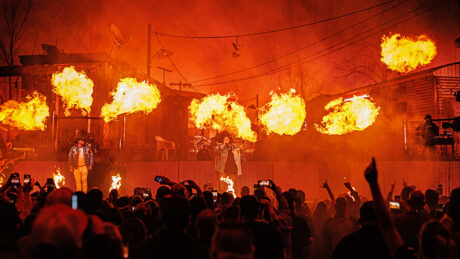
What’s something you would hope another designer might notice in your design?
The layering and the texture. We tried to build a base for every look and then bring lights around it. No matter what we were doing, we didn’t want to lose the context of the architecture of this thing. We were trying to treat it a little bit like a TV show in the sense of there’s always a base in the fixtures, there’s always something happening. No matter what angle you look at it from, there’s something interesting in the background. I really tried to spend a lot of time looking at the camera plot and trying to figure out, that if you’re looking at him from 360˚ at any given time, what’s in the background. Darien Koop was my Associate Designer on site and Lighting Director. Darien’s an Emmy-nominated lighting director and I do a lot of television, so when we come to touring work, we really try to focus on lighting the show, not just for the room, but really making it look great for the camera as well, not blow things out. There are moments where it blows out, and that’s okay, it looks great and it’s part of the show. But overall, I really try to keep things balanced.
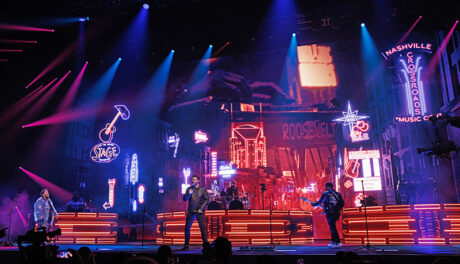
How involved was Jelly Roll in the looks of the show?
He was involved but he also let us run wild, which was great. He let us build something and we showed it to him. He was very fascinated by the programing process. He came into rehearsals and sat down with me at the console at one point and I let him play with the lights. We actually talked at length about how programming works and from the beginning how we build the thing and where it ends up. And he gave a couple color notes. He gave a couple notes of where he wanted hits and strobes. He was just very supportive. You felt like he was really happy with what we were doing for him and the show. I will say he was there grinding it out in rehearsals with us the whole time. Even while we were programming, he was hanging out in the back of the room and would occasionally come up and give us a note about where he was going to be standing. He was definitely present and part of the process and supportive. He was very cool to work with. The whole team, everybody that was there was really into it and it was an honor to be a part of it. It felt like being a part of Nashville history. I grew up two hours north of Nashville, in a little town in Kentucky, and so Nashville is where we would always come to go see concerts. I don’t work there much now, I work in LA almost all year, so for me to be there and be part of this was really cool. It really was a concert for the people from Nashville, for this guy who has really worked his way up through Nashville from the bars to the Bridgestone Arena.
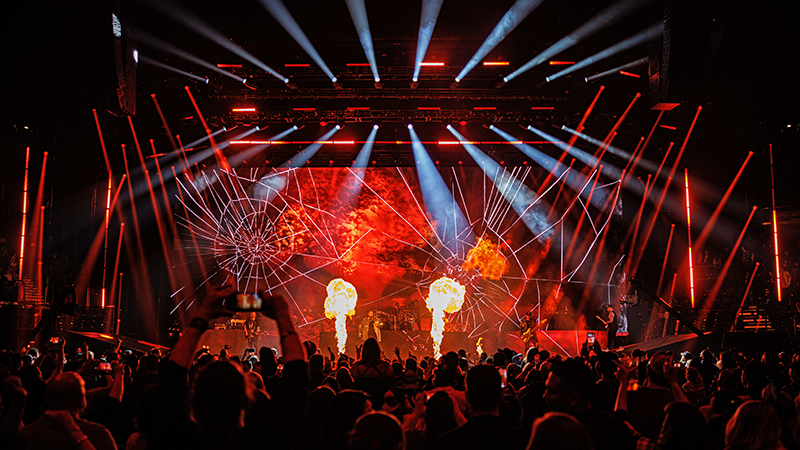
David Pawsey, Lüz Studios Creative Director
What was your scope of work for the Jelly Roll show at the Bridgestone?
It was to create the video content for the show essentially, so that meant to conceptualize and to design it, and then to animate and integrate it. We collaborated with the production team from Fireplay. We wanted to create something theatrical, create these digital sets. We all wanted to make sure that technically we could actually achieve that, which I think we did, by having a canvas that would allow for these virtual sets to live and to be articulated.
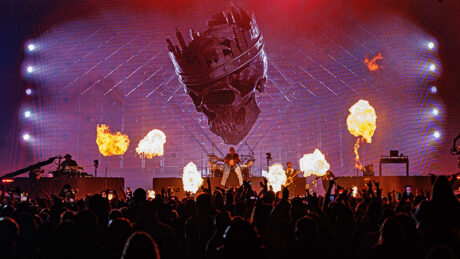
Where do you start on a project like this?
Our first meeting was with Jelly Roll’s team. Going over what they wanted to achieve thematically. As I said they wanted this to be more of a theatrical approach; creating four main acts, and each act being a specific place. The first environment was more an adaptation of his logo, the crying skull with the crown figure. Everyone thought that would be a good opening setting, without it being overly branded, no name, just that actual symbol, and then building a virtual lighting rig around it. Creating a wow start more like the start of a rock show. We also had some traditional I-Mag and some Notch effect treated I-Mag.
We then went into our first real set, which was the trailer park. That’s where he comes from and a lot of his backstory as a person, as an artist, came from there. That was cool, creating this virtual trailer park that could play for three, four songs and just change color, be synced with the actual lighting rig and be able to jam live as well, because it’s not a time coded show at all. We really needed to be following Jelly, which was a fun challenge. Doing these virtual sets really allowed us to be in sync with the artist, but let the artist also be able to just go off whenever he felt appropriate. From the trailer park, we went to a bar environment. We created an interior of a dive bar with an atmosphere that was a fun place to be in. Another set that we built was important as well because there were a lot of Nashville guest artists joining Jelly Roll, we created a virtual skyline of Nashville as if you were on Broadway. Seeing all those neon signs coming to life and being able to integrate the I-Mag. That was a really fun environment to create as well. But really for Jelly, the main environments where the trailer park, the dive bar, and the third being the interior of a church. That one is more a symbol of redemption and hope, and how his life has been completely changed. It wasn’t about having a religious undertone, just being a symbol of positive change.
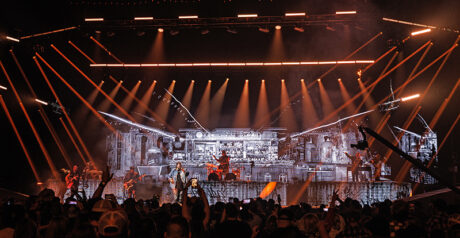
Tell us about working with Bobby Grey. Did you mimic some of what he was doing in the lighting in the virtual set so that it would blend together?
There were some songs that we were further ahead so he followed us, and then there were others where it was the other way around. For one song we had a pass and then he pulled an all-nighter, and the result was amazing, marrying the blow through with the church lighting; it created a really special moment. For us it was unexpected and that is what’s fun about virtual environments, you can then hand it over to an LD and the whole thing becomes something cool and unexpected.
There’s two ways of working together doing virtual sets. There’s one way where you have months and months and months of prep and you’re fully in sync, and then there’s other times where it’s like, okay, you need to rely on the professionalism of the people around you and the artistic eye and see where they can adapt it afterwards because there isn’t all that time ahead. The workflow for our virtual sets allows this flexibility to give an LD an opportunity to light it how he wants to, change colors to what he wants, and we can adapt really quickly to that. There’s a lot of flexibility for change working in real time, without having to re-render anything and all that. That let him work and create this wonderful moment.
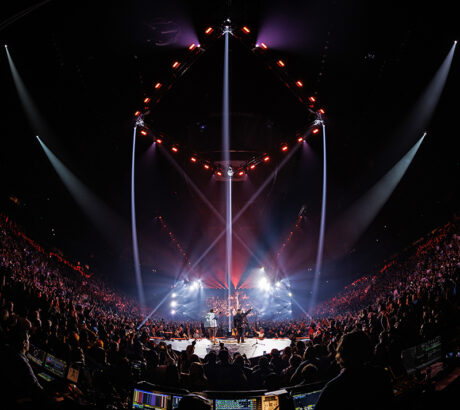
How flexible can you be during rehearsals?
What we do is work up a series, a whole bunch of cues set up, it’s really all layered. We can stack things and change things pretty quickly. If we know some of the songs are going to have vamping or going to have ad lib moments or whatever, it’s programed so that we can stay with him, sort of a looping an environment if we need to, and we can punch through manually as well. Like for the trailer park, we have different skies, different lighting effects, we could have lightning. It’s all real-time layering. It’s a lot of pre-production. We have a workflow that’s becoming part of our DNA so that we can actually go in and plan ahead with tons of variety. Then we can be flexible during integration and rehearsals when there are changes. Because so much of what we’re doing is borderline photorealistic to re-render everything and recalculate anything is just not a reality. So, we ensure that we have everything prepped.
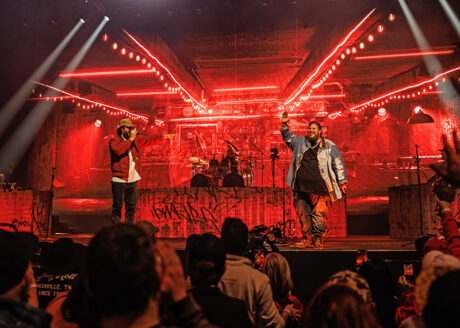
Any final thoughts about this show and working with Jelly Roll?
In the end I think it is all about making sure that the virtual sets and the lighting and everything else helps focus the attention on the artist. For this show, the virtual sets really helped do that. It needed those environments since it was a more theatrical show, rather than if you had a whole bunch of VJ-style animations behind the artist. That would have taken focus away from the artist. I think our being able to integrate the I-Mag within those virtual sets, it builds a set where you have an illusion of dimension on stage, but you also have time to focus on the artist and on the lighting and just being in the moment a little bit more.
About Jelly Roll, I would say that he is a really interesting person, very accommodating, generous with his time, and can sing. I certainly am a new fan. We went in with an open mind, not knowing the music or the artist, and we are so happy we did because it really was a surprising show and a surprising artist. I think the future’s really bright for him.
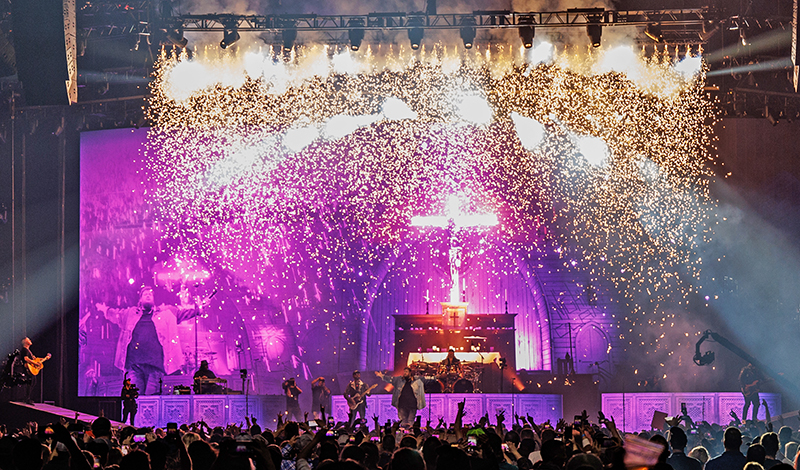
Production Team
- Management: John Meneilly
- Production Manager: Eddie Kercher
- Creative Producers: Nick Whitehouse & Brian Vaughan / Fireplay
- Lighting Designer: Bobby Grey / Notan Creative
- Associate Lighting Designer: Darien Koop
- Production Designer: Josh Zangen
- Lighting Crew Chief/Master Electrician: Dave Carr
- Screens, Notch, Media: Lüz Studio
- Video Programmer & Operator: Philippe Marquis
- Video Director: Nate Fountain
LÜZ Studio Media Integration Team
- Creative Director: David Pawsey
- Creative Producer: MC Dufort
- Artistic Director: Matthieu Larivee
- Notch Designer: Simon Rouhier
- Additional Luz Studio Designers:
- 3D Designers: Sindre Peladeau, David Poirier, Vincent Laquerre
- Virtual Lighting Designer: Camille Joubert
- Compositing: Maxime Lortie
- Motion Designers: Sebastien Deschenes, Joanna Czadowska
Vendors
- Lighting and Video: Solotech / Lee Moro
- Special Effects & Pyro: Pyrotecnico
- Staging: Gallagher Staging & Production
